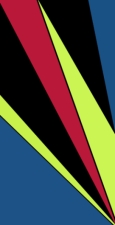Iru.c
Software, Two Digital Prints on Canvas, 2008
180 x 92 cm (each print)
Click on images for larger versions.

 Iru.c is a computer program written by the artist that draws a reproduction of Swedish painter Olle Baertling's 1958 work, Iru. The new work is presented as two digital prints on canvases that are identical in size to Baertling's original painting. One print contains the output drawn by the program, the other contains the complete code of the program itself. The text on the second print is color-coded such that segments of code that are directly responsible for drawing are printed in the color that they draw. The prints are intended to be hung together with the original painting so as to initiate a confrontation between the copy and the original, between the formula and the result, between the digital and the analogue, between complexity and simplicity, and between the machine-produced and the hand-made.
Iru.c is a computer program written by the artist that draws a reproduction of Swedish painter Olle Baertling's 1958 work, Iru. The new work is presented as two digital prints on canvases that are identical in size to Baertling's original painting. One print contains the output drawn by the program, the other contains the complete code of the program itself. The text on the second print is color-coded such that segments of code that are directly responsible for drawing are printed in the color that they draw. The prints are intended to be hung together with the original painting so as to initiate a confrontation between the copy and the original, between the formula and the result, between the digital and the analogue, between complexity and simplicity, and between the machine-produced and the hand-made.
Iru.c is a response to Iru specifically, and to Baertling's paintings made after 1953 generally. The content of these paintings, seemingly simple straight lines, triangles, and quadrilaterals drawn with a limited palette of three or four colors, echoes the content of both early computer graphics, which were constrained by technical limitations, and the first assignments or experiments of every new computer graphics programmer, who typically begins with these simple, abstract forms in few colors as building blocks for more complex graphical programs. At the same time, in their extensive, iterative exploration of a well defined, narrowly limited set of choices of color, shape, and arrangement, Baertling's paintings seem like an embodiment of a computer-like process, an enumeration and examination of an infinitely large set of cases (data) with only slight variations between them that would inevitably exhaust the patience and capacity of a human mind. This process seems to be pursued for the same reason that many computer programs are written, to arrive at some kind of digestible, summary solution.
The artist presents the Iru.c program and its output drawing as a sort of challenge to the original paintings, proposing, though not really believing, that the paintings are simple and that a program can produce the same results easily, formulaically, and completely. The challenge is issued not to belittle the paintings, but rather to allow the paintings to confront the challenge and thus produce a dialog. In this confrontation, the seemingly simple painting answers the challenge by revealing an authentic, hand-made elegance, depth, and complexity. In contrast, next to the painting, the relatively simple formula of the code looks more complex, perhaps overly so, while the program's reproduction of the painting looks more precise, blunt, and simple.

 Iru.c is a computer program written by the artist that draws a reproduction of Swedish painter Olle Baertling's 1958 work, Iru. The new work is presented as two digital prints on canvases that are identical in size to Baertling's original painting. One print contains the output drawn by the program, the other contains the complete code of the program itself. The text on the second print is color-coded such that segments of code that are directly responsible for drawing are printed in the color that they draw. The prints are intended to be hung together with the original painting so as to initiate a confrontation between the copy and the original, between the formula and the result, between the digital and the analogue, between complexity and simplicity, and between the machine-produced and the hand-made.
Iru.c is a computer program written by the artist that draws a reproduction of Swedish painter Olle Baertling's 1958 work, Iru. The new work is presented as two digital prints on canvases that are identical in size to Baertling's original painting. One print contains the output drawn by the program, the other contains the complete code of the program itself. The text on the second print is color-coded such that segments of code that are directly responsible for drawing are printed in the color that they draw. The prints are intended to be hung together with the original painting so as to initiate a confrontation between the copy and the original, between the formula and the result, between the digital and the analogue, between complexity and simplicity, and between the machine-produced and the hand-made.